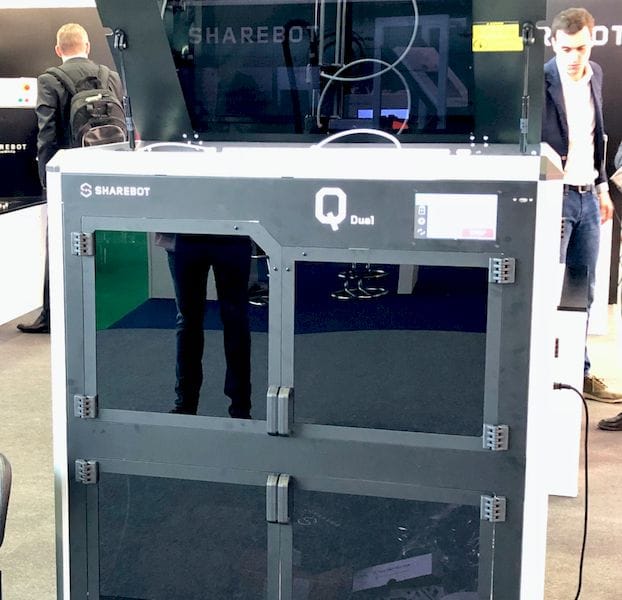![Sharebot's Q Dual Professional 3D Printer [Source: Fabbaloo]](https://fabbaloo.com/wp-content/uploads/2020/05/image-asset_img_5eb09e745d4bd.jpg)
We had a look at Sharebot’s new Q Dual professional 3D printer.
The Italian manufacturer of 3D printers has been operating for quite some time, having issued their first products way back in 2011, making them one of the older 3D printer manufacturers.
They began by shipping simple desktop units, but over the years their products have evolved into far more sophisticated devices like the Q, introduced in 2016. One of their latest machines is the Q Dual professional 3D printer.
This rather large machine has a build volume of up to 700 x 270 x 300 mm – more about that later. This should accommodate 3D printing large objects, as the machine is also fully enclosed to capture heat.
![A chair 3D printed - in sections - by Sharebot [Source: Fabbaloo]](https://fabbaloo.com/wp-content/uploads/2020/05/image-asset_img_5eb09e74cb36d.jpg)
Here we see an example of a large 3D print – a fully usable 3D printed chair. It’s been 3D printed in sections and then assembled after printing.
As is indicated by the machine’s name, this is a dual extrusion device, but there’s a big difference from typical dual devices that simply bolt two hot ends to the motion carriage and they move synchronously.
In the Q Dual the extruders operate independently. This potentially allows a number of different printing configurations, including duplication, mirroring, or simply doubling print speed by having two extruders work on one object.
![The independent extruders on the Sharebot Q Dual 3D printer [Source: Fabbaloo]](https://fabbaloo.com/wp-content/uploads/2020/05/image-asset_img_5eb09e754a91c.jpg)
There are a few competitive machines that offer independent dual extruders, but the Sharebot Q Dual has an interesting angle: while both of the hot ends are capable of hitting 450C and are made entirely of metal, allowing use of engineering materials, one of the extruders has a much larger nozzle diameter.
One nozzle is 0.4mm, a standard size, and the other 0.8mm, a larger size that allows 4X the amount of material to be deposited at a time. This could, for example, be used to quickly deposit unseen infill material at a much higher speed, thus decreasing overall print duration.
Another possibility is to use the larger nozzle for support material, which could again be very quickly deposited to speed the print.
One more thing: the build volume of this machine changes slightly depending on how you’re using the dual extruders. If using only a single extruder in a print, then the build volume will be the full 700 x 270 x 300 mm. However, if you are performing a dual extrusion print the second extruder will occupy some of the range that the first extruder would otherwise be able to access. Thus in dual mode the build volume shrinks slightly to only 700 x 250 x 300 mm. It’s not a big difference and most prints will not be affected by this whatsoever.
We’re told the price of the Q Dual machine is set at €11,000 (US$12,500).
Via Sharebot











FELIXprinters has released a new bioprinter, the FELIX BIOprinter, which is quite a change for the long-time 3D printer manufacturer.